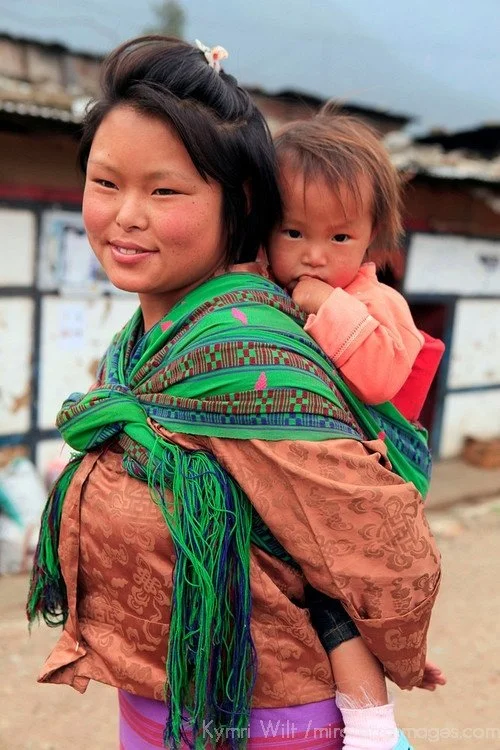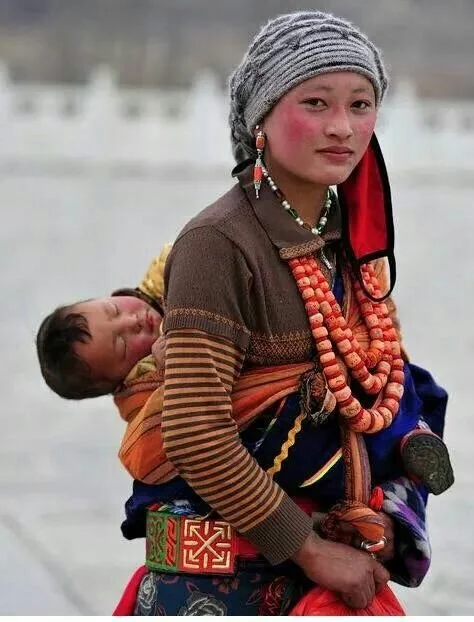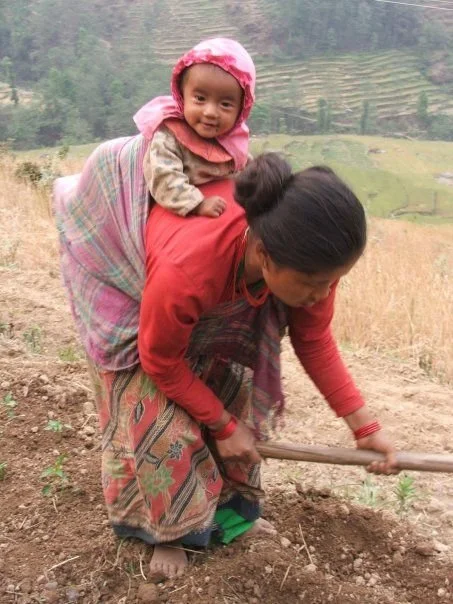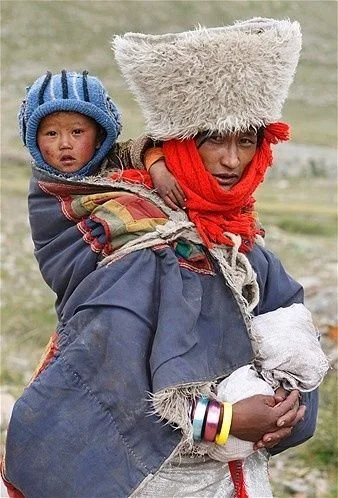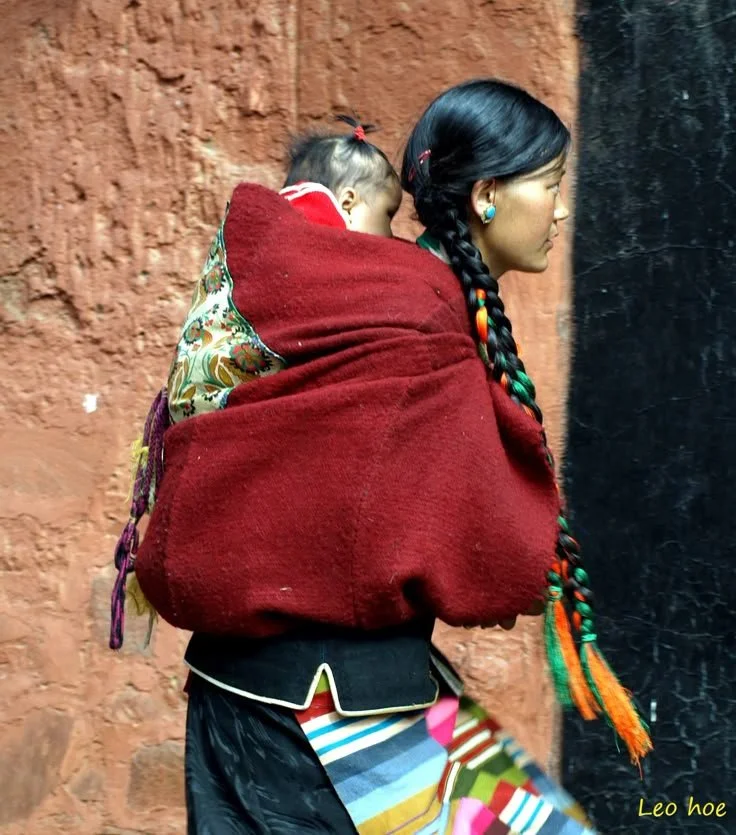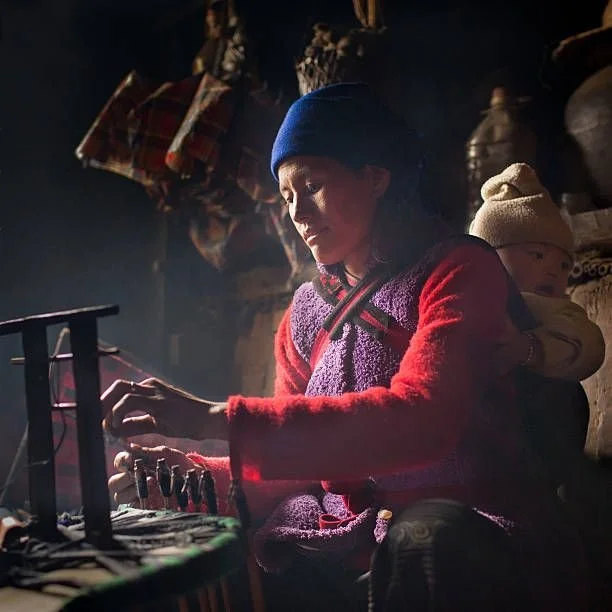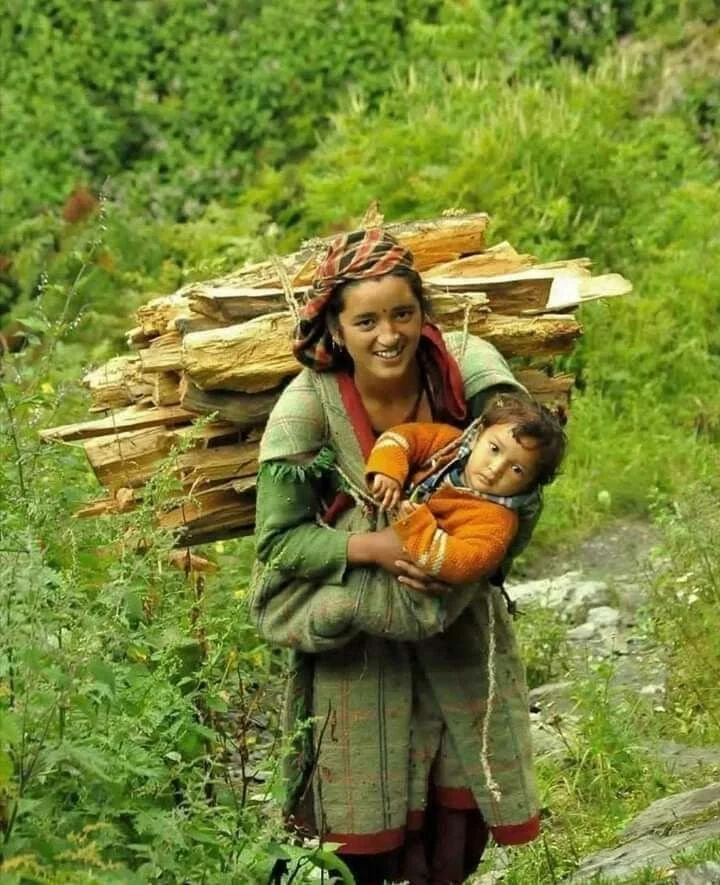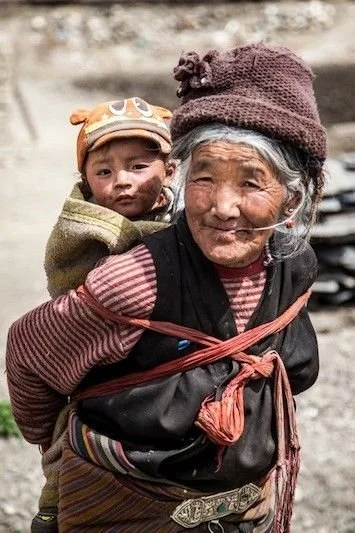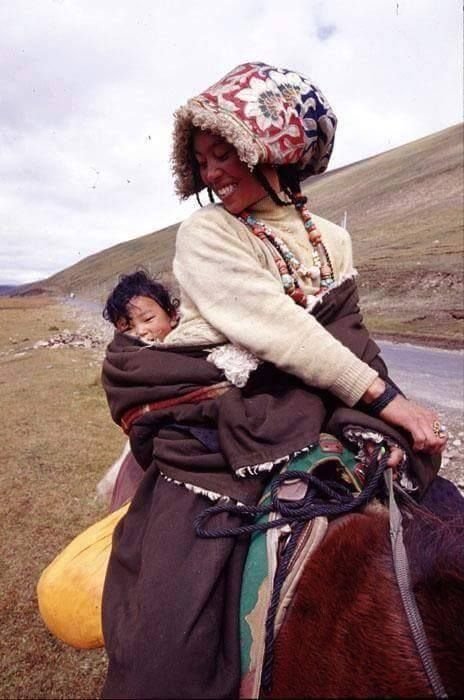Himalayan Highlands: Woven Paths Above the Clouds
High in the rugged mountain ranges of the Himalayas, carrying a baby is not simply about transport — it is about survival, belonging, and deep spiritual connection. In this region spanning Nepal, Bhutan, northern India (including Ladakh and Sikkim), and Tibet, babywearing practices are shaped by harsh climates, steep paths, and tightly woven community life.
Mothers and caregivers in these highland cultures use wide woven cloths or shawls, often called bhako, patuka, or similar local names, to secure babies snugly to their backs. The cloth is wrapped high and tight, allowing caregivers to climb terraces, navigate rocky trails, and perform daily tasks with both hands free while keeping the baby close and warm. Babies peeking over their mother’s shoulder learn the landscape from the start — mist-covered valleys, prayer flags dancing in the wind, the gentle rhythm of yak bells echoing along mountain paths.
These carrying cloths are not just functional; they are deeply symbolic. Weaving traditions in Himalayan communities are often closely tied to family identity and spiritual beliefs. Patterns and colors can signify clan ties, protective blessings, or wishes for the child's health and strength. The act of weaving and carrying is seen as a meditation in itself — a way to embed love, patience, and intention into each thread and knot.
Community elders teach young mothers how to tie these cloths properly, sharing stories, chants, and prayers during the process. Through this, babywearing becomes a living transmission of cultural knowledge and an act of communal care.
While modernization and imported parenting products have influenced some urban areas, many Himalayan families continue to rely on traditional carrying practices, especially in rural villages and among those dedicated to preserving ancestral ways.
To be carried in the Himalayas is to be wrapped not only in fabric but in mountain winds and ancestral breath — a blessing whispered between earth and sky, welcoming the baby into the heart of the mountains and the warmth of their people.
Bhutan
This joyful mother from Bhutan carries her child in a traditional back carry, using a vibrant woven shawl to secure the baby close. In Bhutanese culture, carrying children in this way supports both warmth and connection, keeping little ones comforted in the cool mountain air while allowing mothers to move freely through daily life. The intricately patterned textile reflects Bhutan’s rich weaving heritage, where colors and motifs often symbolize protection and prosperity. The baby’s curious gaze and the mother’s warm smile together capture the spirit of love and resilience that flows through generations. To be carried in Bhutan is to feel the heartbeat of the Himalayas and to grow up wrapped in stories, traditions, and community warmth.
Ladakh
This radiant mother from Ladakh, a high-altitude region in northern India, carries her baby snugly wrapped in thick woolen blankets against the stark Himalayan winds. In Ladakhi communities, warmth and closeness are essential, and babies are kept near their caregiver’s body to share heat and heartbeat alike. The use of layered wool not only protects the child from the cold but reflects a deep resourcefulness shaped by life in the mountains. Her woven hair and the baby’s rosy cheeks speak of resilience, joy, and the strong threads of cultural identity that bind mother and child. To be carried in Ladakh is to feel the crisp mountain air and to grow up knowing that love and warmth can weather any storm.
Tibet
Among Tibetan nomadic and rural communities, mothers carry their babies wrapped high on their backs, nestled into thick cloths that shield them from the sharp mountain winds. Here, a mother adorned with coral and amber beads stands with quiet strength, her child sleeping deeply against her warmth. Each bead, each layer of fabric, tells a story of resilience, prayer, and deep connection to the land. As she walks across wide plateaus and prayer-flag-strewn paths, her baby listens to the heartbeat of the highlands, carried forward in the gentle sway of tradition and maternal love.
Nepal
In the terraced hillsides of Nepal, mothers wrap their babies high on their backs in striped shawls called pachheura, so they can work the earth and nurture life side by side. Here, a mother bends to tend her fields while her baby gazes out with bright, curious eyes, sharing in the songs of birds and the rhythm of the hoe. In each careful knot and each strong stride lies a quiet strength: a promise that no matter the climb or the harvest ahead, her child is held safe, carried through each sunrise and season in a warm, unwavering embrace.
Ladakh
In the windswept heights of Ladakh, mothers carry their children wrapped in thick woolen cloths and adorned with brilliant woven sashes, each color echoing the vast Himalayan skies and valley flowers. Here, a mother stands in her traditional perak headdress, her child peeking curiously from behind her shoulder, snug against the biting cold. Every layer she wears speaks of ancestral resilience and the intimate knowledge of life lived between snowy passes and high plateaus. To be carried in this way is to learn the mountain’s breath, the weight of community, and the warmth of a mother’s unwavering presence — woven together in each careful step.
Tibet
This striking image shows a Tibetan mother carrying her baby in a richly layered traditional wrap. In Tibetan culture, babies are often secured on the caregiver’s back using warm, thick cloths and intricately decorated textiles that reflect the region’s deep connection to color, symbolism, and spiritual life. The baby rests snugly against the mother, sharing her body warmth while moving through high mountain villages or bustling monasteries. The bright woven tassels and carefully braided hair express both beauty and cultural pride. To be carried this way is to be enveloped in warmth, protected by family traditions, and introduced to the world from a place of security and love.
Tibet
This Tibetan mother carries her child across the vast, windswept plateau, wrapped in thick layers of wool and fur that echo the strength and warmth of her embrace. In Tibetan culture, babies and young children are secured high on the caregiver’s back using woven sashes and wide bands, often lined with sheepskin for insulation against the biting cold. Each colorful fabric and intricate accessory reflects regional artistry and the family’s connection to the highland earth. To be carried in Tibet is to feel the expansive sky overhead, the steady rhythm of a mother’s steps, and the unwavering bond that ties child, caregiver, and land into a single, shared breath.
This powerful image captures a woman from the Himalayan region, likely Ladakh or Tibet, carrying her child close against the mountain sun and wind. Wrapped securely in a warm woolen cloth, the child shares in every moment of daily life, sheltered by the caregiver’s protective embrace. Her bright turquoise headscarf and layered jewelry speak to a rich tradition of adornment and identity, while her weathered face tells a story of strength and endurance. To be carried in this way is to feel the heartbeat of the highlands, to learn resilience from birth, and to know that even in the harshest landscapes, warmth and connection are woven tightly together.
Bathed in soft indoor light, this mother from the Himalayas tends to her weaving while her baby rests close on her back, wrapped snugly in warm layers. The baby’s watchful eyes and the rhythmic movement of the mother’s hands embody the seamless integration of caregiving and craft. In these high-altitude communities, textiles are not just clothing or carriers but cultural lifelines — each thread connecting generations, each pattern holding ancestral knowledge. To be carried this way is to learn from every woven line, to absorb stories of resilience and artistry, and to share in the quiet, enduring work of keeping family and tradition alive.
In the Himalayan foothills of India, among communities such as the Gaddi people of Himachal Pradesh, babywearing is woven seamlessly into daily life in the mountains. This mother carries her child securely at her side with a simple woven cloth while also hauling a heavy bundle of firewood — a testament to strength, adaptability, and deep connection. The textiles, often handwoven from wool, reflect local knowledge of the land and the harsh yet beautiful highland climate. Babies learn the rhythms of the forest and the village from this close vantage point, feeling every step on the mountain paths and hearing the sounds of birds and wind in the pines. To be carried here is to be held within both the warmth of family and the embrace of the mountains themselves.
This tender image captures a Tibetan grandmother carrying her grandchild on her back, wrapped securely in a woollen blanket and wide sash across her chest. In Himalayan communities, babywearing is not only the work of mothers but a shared act of care by elders and extended family. Grandmothers play a vital role in raising children, passing on stories, songs, and wisdom through each gentle sway. The layered clothing, earthy textiles, and deeply lined smiles tell of resilience and warmth in the harsh mountain climate. To be carried in this way is to be woven into generations of love, supported by strong backs and even stronger hearts.
In the cold, high-altitude villages of northern India, mothers and grandmothers wrap babies snugly in richly patterned shawls or woollen blankets. Here, warmth and closeness are vital, not only for protection against the mountain air but also for nurturing the deep bond between caregiver and child. As women go about daily life — gathering firewood, tending animals, or visiting neighbors — babies ride on their backs, secure and calm, soothed by the soft sway and the warmth of woven cloth. To be carried in this way is to feel the pulse of life in the mountains: strong, enduring, and filled with quiet joy.
From the very beginning of human history, carrying our babies has been far more than a simple means of transport — it has always been an expression of love, connection, and survival. Across every climate and culture, babywearing has remained a constant thread, evolving to meet different needs and environments, yet always centred on keeping babies close to their caregivers’ hearts.
A note of gratitude and respect
We respectfully acknowledge and honor the individuals and communities depicted in historical images throughout this series. Many of these photographs were taken in times and contexts where informed consent as we understand it today was not sought or given, and some may have been created through coercion or exploitation.
We share these images with the deepest gratitude, not to romanticize or objectify, but to recognize and celebrate the strength, resilience, and wisdom of these cultural practices. We hold these ancestors and knowledge holders in our hearts and aim to represent their traditions with integrity, humility, and care.
We commit to continuing to learn, listen, and uplift the voices of contemporary community members and descendants, and we welcome guidance on the respectful sharing of these images.

